THE ETHICS AND GOVERNANCE
VerifiedAdded on 2022/08/29
|11
|2780
|17
AI Summary
Contribute Materials
Your contribution can guide someone’s learning journey. Share your
documents today.
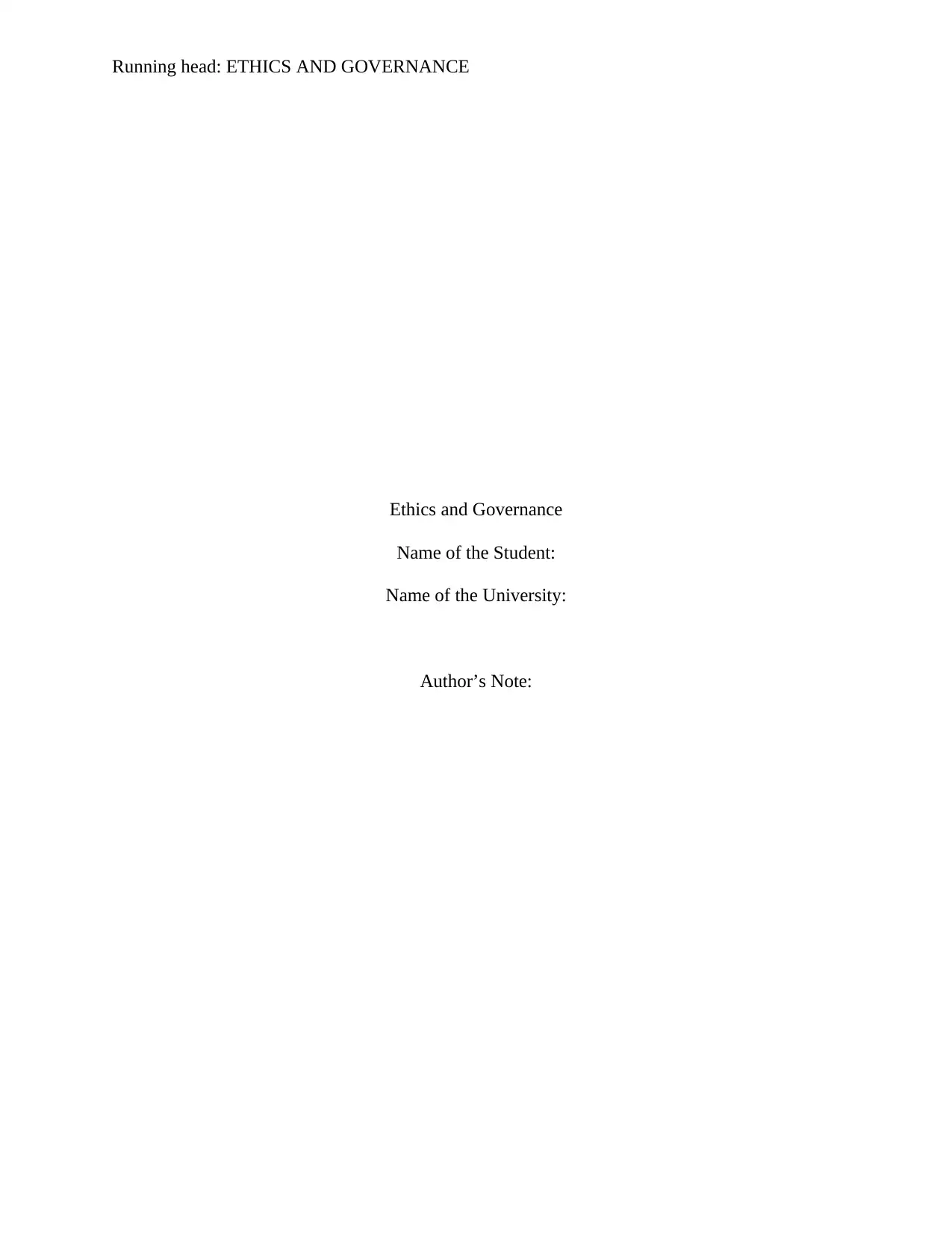
Running head: ETHICS AND GOVERNANCE
Ethics and Governance
Name of the Student:
Name of the University:
Author’s Note:
Ethics and Governance
Name of the Student:
Name of the University:
Author’s Note:
Secure Best Marks with AI Grader
Need help grading? Try our AI Grader for instant feedback on your assignments.
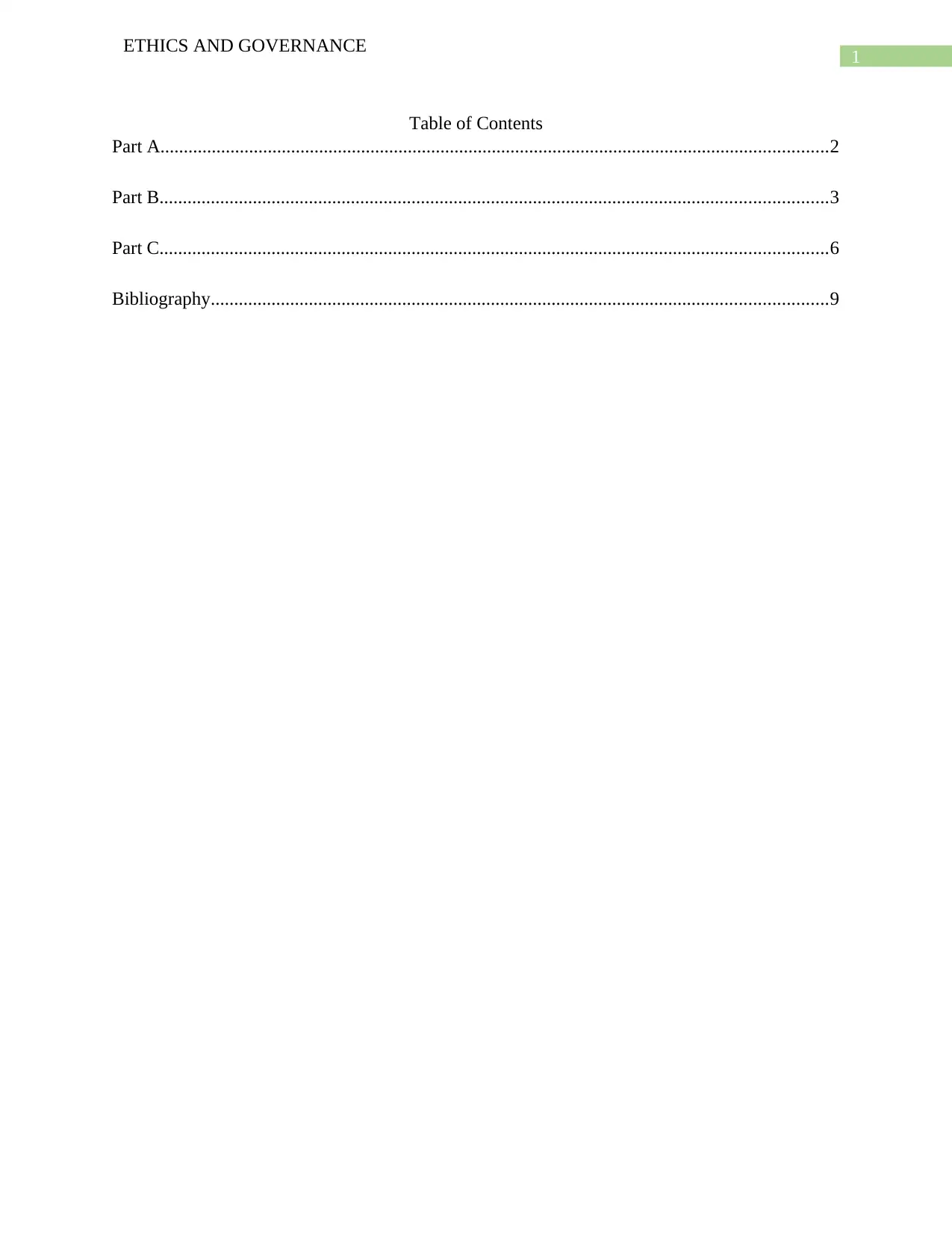
1
ETHICS AND GOVERNANCE
Table of Contents
Part A...............................................................................................................................................2
Part B...............................................................................................................................................3
Part C...............................................................................................................................................6
Bibliography....................................................................................................................................9
ETHICS AND GOVERNANCE
Table of Contents
Part A...............................................................................................................................................2
Part B...............................................................................................................................................3
Part C...............................................................................................................................................6
Bibliography....................................................................................................................................9
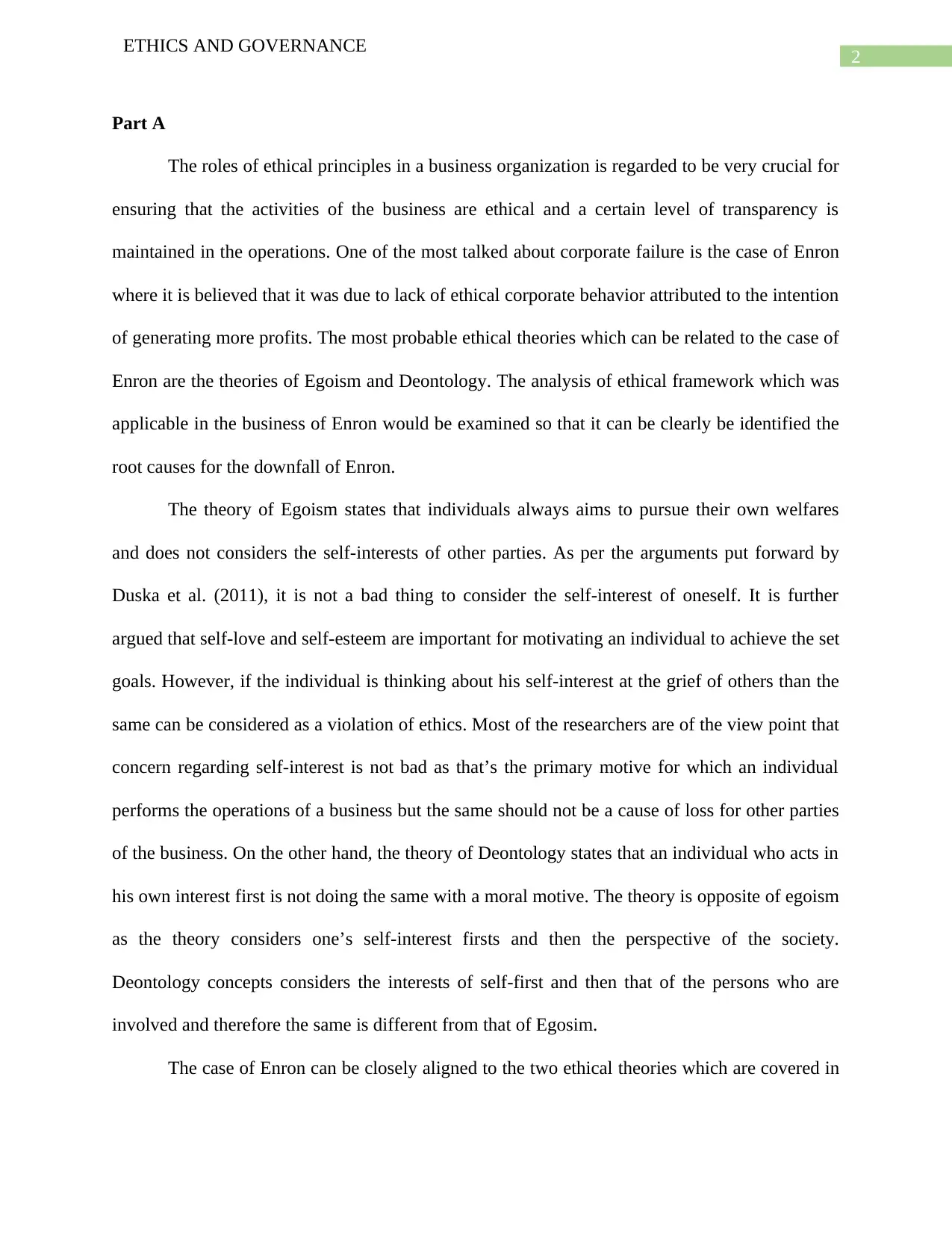
2
ETHICS AND GOVERNANCE
Part A
The roles of ethical principles in a business organization is regarded to be very crucial for
ensuring that the activities of the business are ethical and a certain level of transparency is
maintained in the operations. One of the most talked about corporate failure is the case of Enron
where it is believed that it was due to lack of ethical corporate behavior attributed to the intention
of generating more profits. The most probable ethical theories which can be related to the case of
Enron are the theories of Egoism and Deontology. The analysis of ethical framework which was
applicable in the business of Enron would be examined so that it can be clearly be identified the
root causes for the downfall of Enron.
The theory of Egoism states that individuals always aims to pursue their own welfares
and does not considers the self-interests of other parties. As per the arguments put forward by
Duska et al. (2011), it is not a bad thing to consider the self-interest of oneself. It is further
argued that self-love and self-esteem are important for motivating an individual to achieve the set
goals. However, if the individual is thinking about his self-interest at the grief of others than the
same can be considered as a violation of ethics. Most of the researchers are of the view point that
concern regarding self-interest is not bad as that’s the primary motive for which an individual
performs the operations of a business but the same should not be a cause of loss for other parties
of the business. On the other hand, the theory of Deontology states that an individual who acts in
his own interest first is not doing the same with a moral motive. The theory is opposite of egoism
as the theory considers one’s self-interest firsts and then the perspective of the society.
Deontology concepts considers the interests of self-first and then that of the persons who are
involved and therefore the same is different from that of Egosim.
The case of Enron can be closely aligned to the two ethical theories which are covered in
ETHICS AND GOVERNANCE
Part A
The roles of ethical principles in a business organization is regarded to be very crucial for
ensuring that the activities of the business are ethical and a certain level of transparency is
maintained in the operations. One of the most talked about corporate failure is the case of Enron
where it is believed that it was due to lack of ethical corporate behavior attributed to the intention
of generating more profits. The most probable ethical theories which can be related to the case of
Enron are the theories of Egoism and Deontology. The analysis of ethical framework which was
applicable in the business of Enron would be examined so that it can be clearly be identified the
root causes for the downfall of Enron.
The theory of Egoism states that individuals always aims to pursue their own welfares
and does not considers the self-interests of other parties. As per the arguments put forward by
Duska et al. (2011), it is not a bad thing to consider the self-interest of oneself. It is further
argued that self-love and self-esteem are important for motivating an individual to achieve the set
goals. However, if the individual is thinking about his self-interest at the grief of others than the
same can be considered as a violation of ethics. Most of the researchers are of the view point that
concern regarding self-interest is not bad as that’s the primary motive for which an individual
performs the operations of a business but the same should not be a cause of loss for other parties
of the business. On the other hand, the theory of Deontology states that an individual who acts in
his own interest first is not doing the same with a moral motive. The theory is opposite of egoism
as the theory considers one’s self-interest firsts and then the perspective of the society.
Deontology concepts considers the interests of self-first and then that of the persons who are
involved and therefore the same is different from that of Egosim.
The case of Enron can be closely aligned to the two ethical theories which are covered in
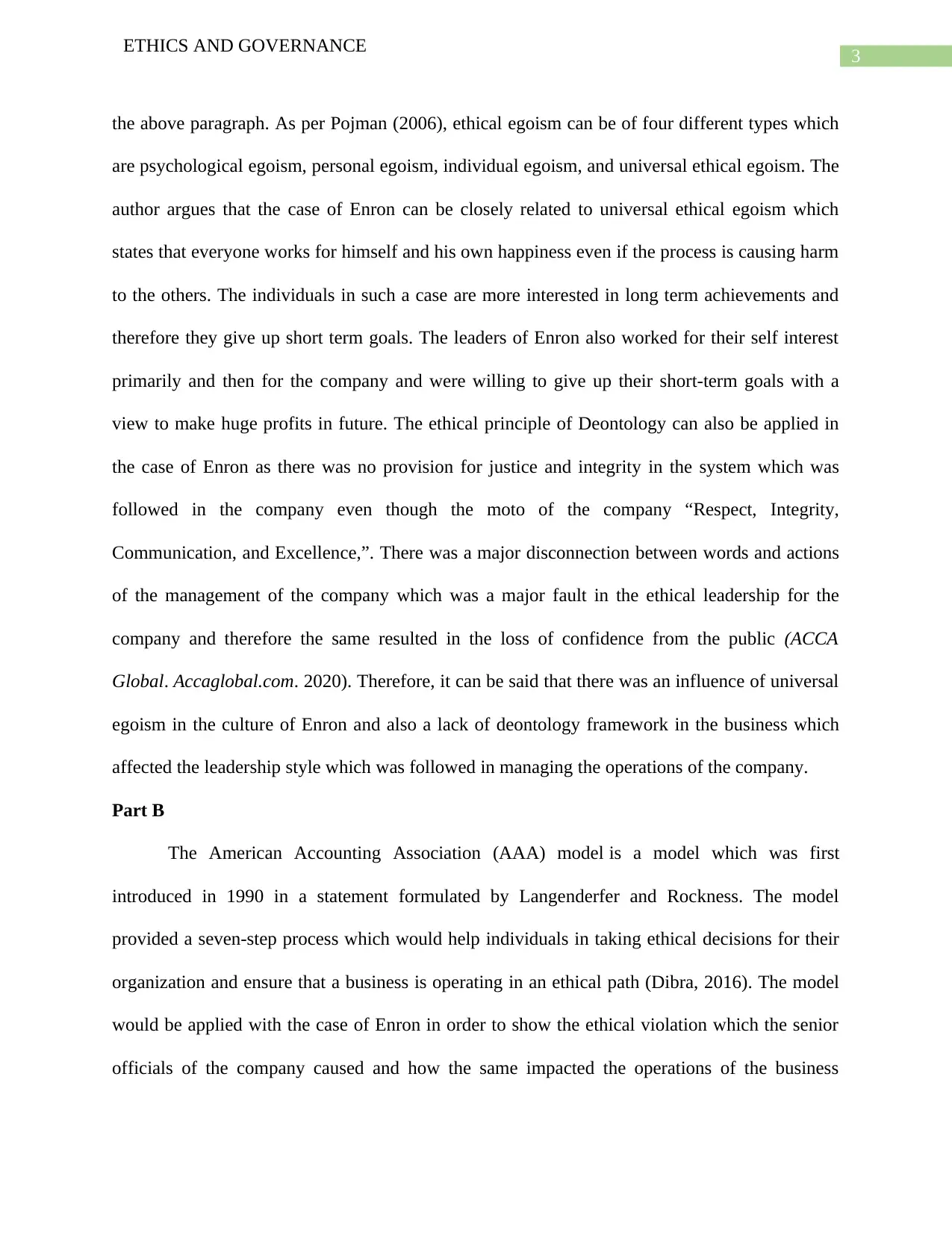
3
ETHICS AND GOVERNANCE
the above paragraph. As per Pojman (2006), ethical egoism can be of four different types which
are psychological egoism, personal egoism, individual egoism, and universal ethical egoism. The
author argues that the case of Enron can be closely related to universal ethical egoism which
states that everyone works for himself and his own happiness even if the process is causing harm
to the others. The individuals in such a case are more interested in long term achievements and
therefore they give up short term goals. The leaders of Enron also worked for their self interest
primarily and then for the company and were willing to give up their short-term goals with a
view to make huge profits in future. The ethical principle of Deontology can also be applied in
the case of Enron as there was no provision for justice and integrity in the system which was
followed in the company even though the moto of the company “Respect, Integrity,
Communication, and Excellence,”. There was a major disconnection between words and actions
of the management of the company which was a major fault in the ethical leadership for the
company and therefore the same resulted in the loss of confidence from the public (ACCA
Global. Accaglobal.com. 2020). Therefore, it can be said that there was an influence of universal
egoism in the culture of Enron and also a lack of deontology framework in the business which
affected the leadership style which was followed in managing the operations of the company.
Part B
The American Accounting Association (AAA) model is a model which was first
introduced in 1990 in a statement formulated by Langenderfer and Rockness. The model
provided a seven-step process which would help individuals in taking ethical decisions for their
organization and ensure that a business is operating in an ethical path (Dibra, 2016). The model
would be applied with the case of Enron in order to show the ethical violation which the senior
officials of the company caused and how the same impacted the operations of the business
ETHICS AND GOVERNANCE
the above paragraph. As per Pojman (2006), ethical egoism can be of four different types which
are psychological egoism, personal egoism, individual egoism, and universal ethical egoism. The
author argues that the case of Enron can be closely related to universal ethical egoism which
states that everyone works for himself and his own happiness even if the process is causing harm
to the others. The individuals in such a case are more interested in long term achievements and
therefore they give up short term goals. The leaders of Enron also worked for their self interest
primarily and then for the company and were willing to give up their short-term goals with a
view to make huge profits in future. The ethical principle of Deontology can also be applied in
the case of Enron as there was no provision for justice and integrity in the system which was
followed in the company even though the moto of the company “Respect, Integrity,
Communication, and Excellence,”. There was a major disconnection between words and actions
of the management of the company which was a major fault in the ethical leadership for the
company and therefore the same resulted in the loss of confidence from the public (ACCA
Global. Accaglobal.com. 2020). Therefore, it can be said that there was an influence of universal
egoism in the culture of Enron and also a lack of deontology framework in the business which
affected the leadership style which was followed in managing the operations of the company.
Part B
The American Accounting Association (AAA) model is a model which was first
introduced in 1990 in a statement formulated by Langenderfer and Rockness. The model
provided a seven-step process which would help individuals in taking ethical decisions for their
organization and ensure that a business is operating in an ethical path (Dibra, 2016). The model
would be applied with the case of Enron in order to show the ethical violation which the senior
officials of the company caused and how the same impacted the operations of the business
Secure Best Marks with AI Grader
Need help grading? Try our AI Grader for instant feedback on your assignments.
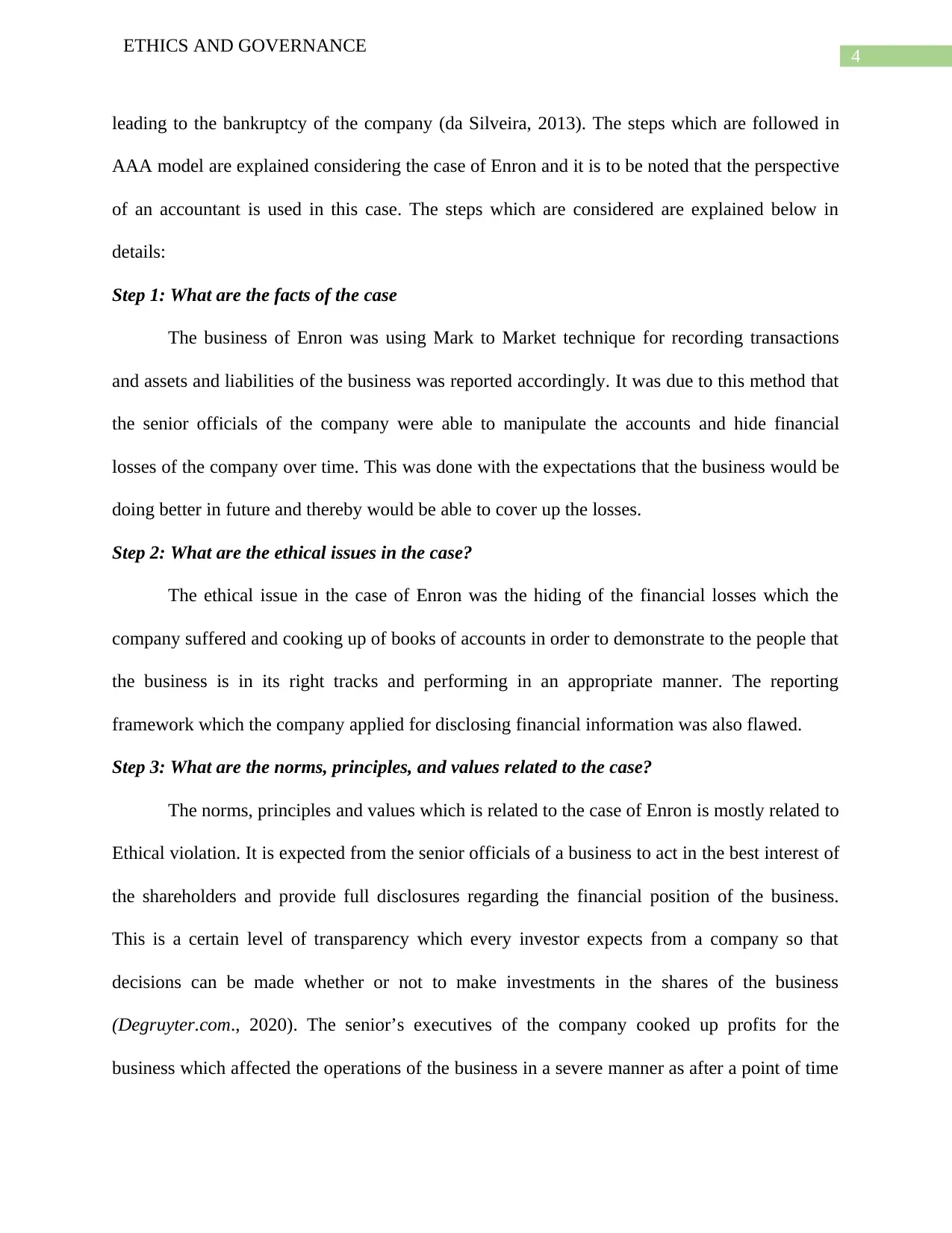
4
ETHICS AND GOVERNANCE
leading to the bankruptcy of the company (da Silveira, 2013). The steps which are followed in
AAA model are explained considering the case of Enron and it is to be noted that the perspective
of an accountant is used in this case. The steps which are considered are explained below in
details:
Step 1: What are the facts of the case
The business of Enron was using Mark to Market technique for recording transactions
and assets and liabilities of the business was reported accordingly. It was due to this method that
the senior officials of the company were able to manipulate the accounts and hide financial
losses of the company over time. This was done with the expectations that the business would be
doing better in future and thereby would be able to cover up the losses.
Step 2: What are the ethical issues in the case?
The ethical issue in the case of Enron was the hiding of the financial losses which the
company suffered and cooking up of books of accounts in order to demonstrate to the people that
the business is in its right tracks and performing in an appropriate manner. The reporting
framework which the company applied for disclosing financial information was also flawed.
Step 3: What are the norms, principles, and values related to the case?
The norms, principles and values which is related to the case of Enron is mostly related to
Ethical violation. It is expected from the senior officials of a business to act in the best interest of
the shareholders and provide full disclosures regarding the financial position of the business.
This is a certain level of transparency which every investor expects from a company so that
decisions can be made whether or not to make investments in the shares of the business
(Degruyter.com., 2020). The senior’s executives of the company cooked up profits for the
business which affected the operations of the business in a severe manner as after a point of time
ETHICS AND GOVERNANCE
leading to the bankruptcy of the company (da Silveira, 2013). The steps which are followed in
AAA model are explained considering the case of Enron and it is to be noted that the perspective
of an accountant is used in this case. The steps which are considered are explained below in
details:
Step 1: What are the facts of the case
The business of Enron was using Mark to Market technique for recording transactions
and assets and liabilities of the business was reported accordingly. It was due to this method that
the senior officials of the company were able to manipulate the accounts and hide financial
losses of the company over time. This was done with the expectations that the business would be
doing better in future and thereby would be able to cover up the losses.
Step 2: What are the ethical issues in the case?
The ethical issue in the case of Enron was the hiding of the financial losses which the
company suffered and cooking up of books of accounts in order to demonstrate to the people that
the business is in its right tracks and performing in an appropriate manner. The reporting
framework which the company applied for disclosing financial information was also flawed.
Step 3: What are the norms, principles, and values related to the case?
The norms, principles and values which is related to the case of Enron is mostly related to
Ethical violation. It is expected from the senior officials of a business to act in the best interest of
the shareholders and provide full disclosures regarding the financial position of the business.
This is a certain level of transparency which every investor expects from a company so that
decisions can be made whether or not to make investments in the shares of the business
(Degruyter.com., 2020). The senior’s executives of the company cooked up profits for the
business which affected the operations of the business in a severe manner as after a point of time
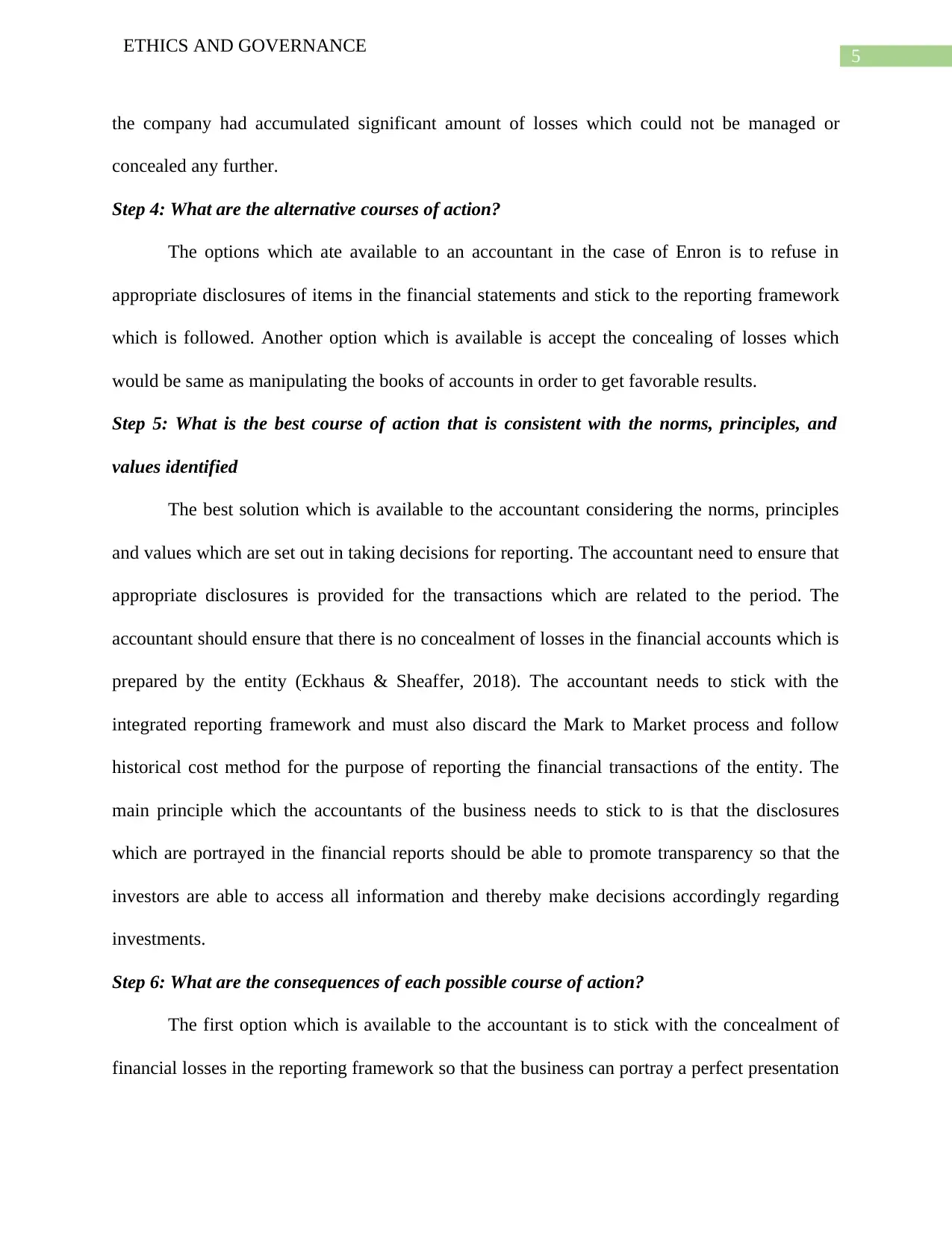
5
ETHICS AND GOVERNANCE
the company had accumulated significant amount of losses which could not be managed or
concealed any further.
Step 4: What are the alternative courses of action?
The options which ate available to an accountant in the case of Enron is to refuse in
appropriate disclosures of items in the financial statements and stick to the reporting framework
which is followed. Another option which is available is accept the concealing of losses which
would be same as manipulating the books of accounts in order to get favorable results.
Step 5: What is the best course of action that is consistent with the norms, principles, and
values identified
The best solution which is available to the accountant considering the norms, principles
and values which are set out in taking decisions for reporting. The accountant need to ensure that
appropriate disclosures is provided for the transactions which are related to the period. The
accountant should ensure that there is no concealment of losses in the financial accounts which is
prepared by the entity (Eckhaus & Sheaffer, 2018). The accountant needs to stick with the
integrated reporting framework and must also discard the Mark to Market process and follow
historical cost method for the purpose of reporting the financial transactions of the entity. The
main principle which the accountants of the business needs to stick to is that the disclosures
which are portrayed in the financial reports should be able to promote transparency so that the
investors are able to access all information and thereby make decisions accordingly regarding
investments.
Step 6: What are the consequences of each possible course of action?
The first option which is available to the accountant is to stick with the concealment of
financial losses in the reporting framework so that the business can portray a perfect presentation
ETHICS AND GOVERNANCE
the company had accumulated significant amount of losses which could not be managed or
concealed any further.
Step 4: What are the alternative courses of action?
The options which ate available to an accountant in the case of Enron is to refuse in
appropriate disclosures of items in the financial statements and stick to the reporting framework
which is followed. Another option which is available is accept the concealing of losses which
would be same as manipulating the books of accounts in order to get favorable results.
Step 5: What is the best course of action that is consistent with the norms, principles, and
values identified
The best solution which is available to the accountant considering the norms, principles
and values which are set out in taking decisions for reporting. The accountant need to ensure that
appropriate disclosures is provided for the transactions which are related to the period. The
accountant should ensure that there is no concealment of losses in the financial accounts which is
prepared by the entity (Eckhaus & Sheaffer, 2018). The accountant needs to stick with the
integrated reporting framework and must also discard the Mark to Market process and follow
historical cost method for the purpose of reporting the financial transactions of the entity. The
main principle which the accountants of the business needs to stick to is that the disclosures
which are portrayed in the financial reports should be able to promote transparency so that the
investors are able to access all information and thereby make decisions accordingly regarding
investments.
Step 6: What are the consequences of each possible course of action?
The first option which is available to the accountant is to stick with the concealment of
financial losses in the reporting framework so that the business can portray a perfect presentation
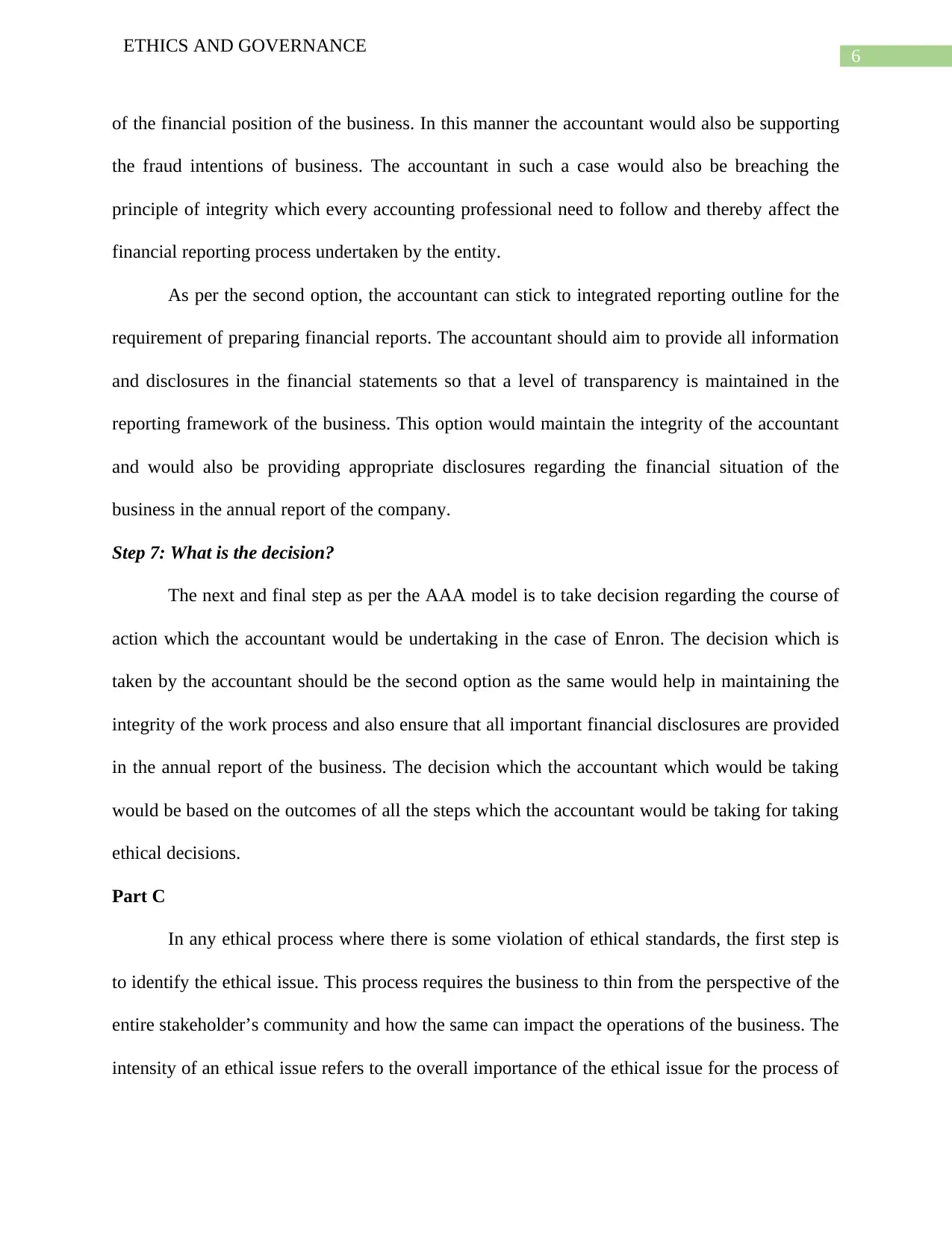
6
ETHICS AND GOVERNANCE
of the financial position of the business. In this manner the accountant would also be supporting
the fraud intentions of business. The accountant in such a case would also be breaching the
principle of integrity which every accounting professional need to follow and thereby affect the
financial reporting process undertaken by the entity.
As per the second option, the accountant can stick to integrated reporting outline for the
requirement of preparing financial reports. The accountant should aim to provide all information
and disclosures in the financial statements so that a level of transparency is maintained in the
reporting framework of the business. This option would maintain the integrity of the accountant
and would also be providing appropriate disclosures regarding the financial situation of the
business in the annual report of the company.
Step 7: What is the decision?
The next and final step as per the AAA model is to take decision regarding the course of
action which the accountant would be undertaking in the case of Enron. The decision which is
taken by the accountant should be the second option as the same would help in maintaining the
integrity of the work process and also ensure that all important financial disclosures are provided
in the annual report of the business. The decision which the accountant which would be taking
would be based on the outcomes of all the steps which the accountant would be taking for taking
ethical decisions.
Part C
In any ethical process where there is some violation of ethical standards, the first step is
to identify the ethical issue. This process requires the business to thin from the perspective of the
entire stakeholder’s community and how the same can impact the operations of the business. The
intensity of an ethical issue refers to the overall importance of the ethical issue for the process of
ETHICS AND GOVERNANCE
of the financial position of the business. In this manner the accountant would also be supporting
the fraud intentions of business. The accountant in such a case would also be breaching the
principle of integrity which every accounting professional need to follow and thereby affect the
financial reporting process undertaken by the entity.
As per the second option, the accountant can stick to integrated reporting outline for the
requirement of preparing financial reports. The accountant should aim to provide all information
and disclosures in the financial statements so that a level of transparency is maintained in the
reporting framework of the business. This option would maintain the integrity of the accountant
and would also be providing appropriate disclosures regarding the financial situation of the
business in the annual report of the company.
Step 7: What is the decision?
The next and final step as per the AAA model is to take decision regarding the course of
action which the accountant would be undertaking in the case of Enron. The decision which is
taken by the accountant should be the second option as the same would help in maintaining the
integrity of the work process and also ensure that all important financial disclosures are provided
in the annual report of the business. The decision which the accountant which would be taking
would be based on the outcomes of all the steps which the accountant would be taking for taking
ethical decisions.
Part C
In any ethical process where there is some violation of ethical standards, the first step is
to identify the ethical issue. This process requires the business to thin from the perspective of the
entire stakeholder’s community and how the same can impact the operations of the business. The
intensity of an ethical issue refers to the overall importance of the ethical issue for the process of
Paraphrase This Document
Need a fresh take? Get an instant paraphrase of this document with our AI Paraphraser
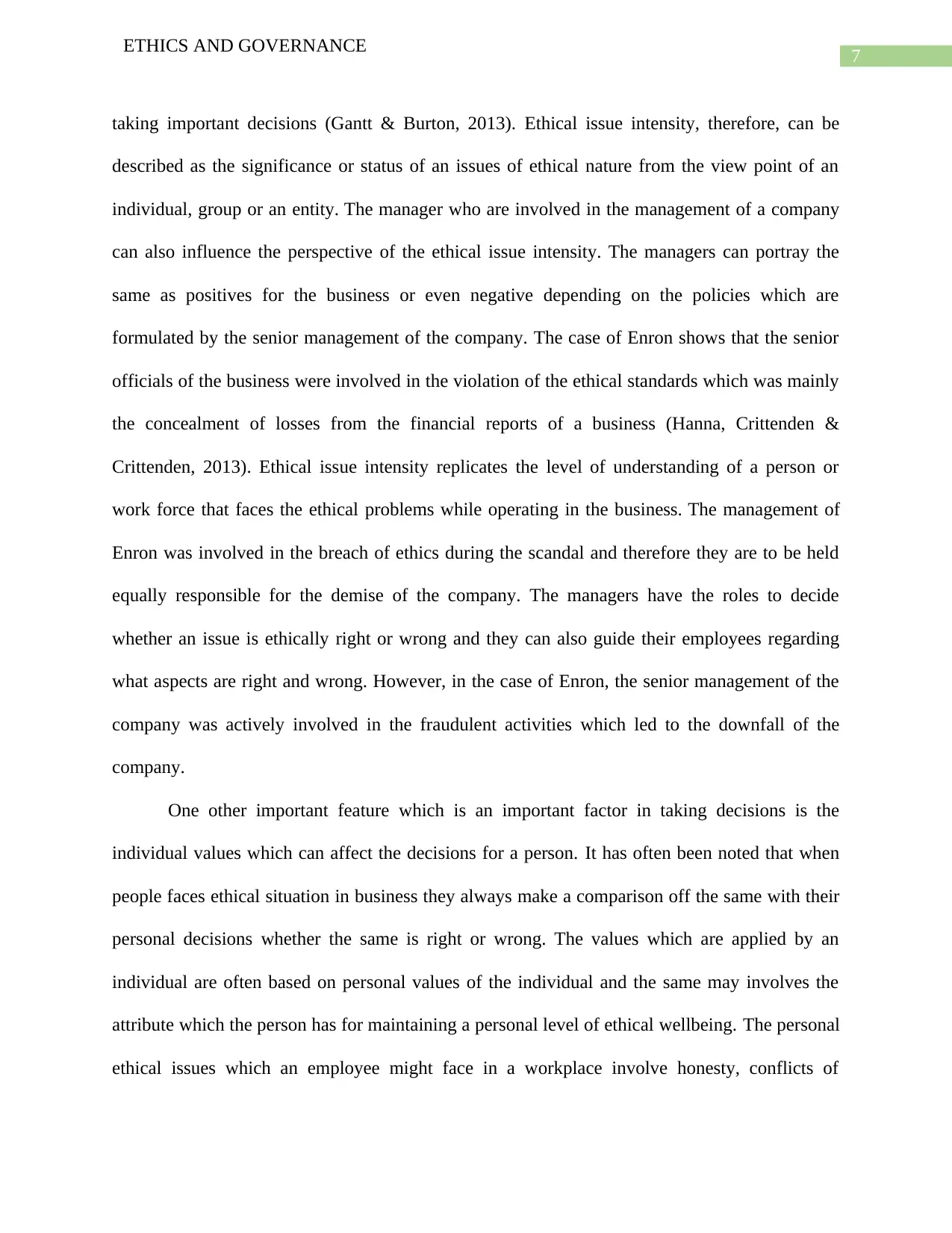
7
ETHICS AND GOVERNANCE
taking important decisions (Gantt & Burton, 2013). Ethical issue intensity, therefore, can be
described as the significance or status of an issues of ethical nature from the view point of an
individual, group or an entity. The manager who are involved in the management of a company
can also influence the perspective of the ethical issue intensity. The managers can portray the
same as positives for the business or even negative depending on the policies which are
formulated by the senior management of the company. The case of Enron shows that the senior
officials of the business were involved in the violation of the ethical standards which was mainly
the concealment of losses from the financial reports of a business (Hanna, Crittenden &
Crittenden, 2013). Ethical issue intensity replicates the level of understanding of a person or
work force that faces the ethical problems while operating in the business. The management of
Enron was involved in the breach of ethics during the scandal and therefore they are to be held
equally responsible for the demise of the company. The managers have the roles to decide
whether an issue is ethically right or wrong and they can also guide their employees regarding
what aspects are right and wrong. However, in the case of Enron, the senior management of the
company was actively involved in the fraudulent activities which led to the downfall of the
company.
One other important feature which is an important factor in taking decisions is the
individual values which can affect the decisions for a person. It has often been noted that when
people faces ethical situation in business they always make a comparison off the same with their
personal decisions whether the same is right or wrong. The values which are applied by an
individual are often based on personal values of the individual and the same may involves the
attribute which the person has for maintaining a personal level of ethical wellbeing. The personal
ethical issues which an employee might face in a workplace involve honesty, conflicts of
ETHICS AND GOVERNANCE
taking important decisions (Gantt & Burton, 2013). Ethical issue intensity, therefore, can be
described as the significance or status of an issues of ethical nature from the view point of an
individual, group or an entity. The manager who are involved in the management of a company
can also influence the perspective of the ethical issue intensity. The managers can portray the
same as positives for the business or even negative depending on the policies which are
formulated by the senior management of the company. The case of Enron shows that the senior
officials of the business were involved in the violation of the ethical standards which was mainly
the concealment of losses from the financial reports of a business (Hanna, Crittenden &
Crittenden, 2013). Ethical issue intensity replicates the level of understanding of a person or
work force that faces the ethical problems while operating in the business. The management of
Enron was involved in the breach of ethics during the scandal and therefore they are to be held
equally responsible for the demise of the company. The managers have the roles to decide
whether an issue is ethically right or wrong and they can also guide their employees regarding
what aspects are right and wrong. However, in the case of Enron, the senior management of the
company was actively involved in the fraudulent activities which led to the downfall of the
company.
One other important feature which is an important factor in taking decisions is the
individual values which can affect the decisions for a person. It has often been noted that when
people faces ethical situation in business they always make a comparison off the same with their
personal decisions whether the same is right or wrong. The values which are applied by an
individual are often based on personal values of the individual and the same may involves the
attribute which the person has for maintaining a personal level of ethical wellbeing. The personal
ethical issues which an employee might face in a workplace involve honesty, conflicts of
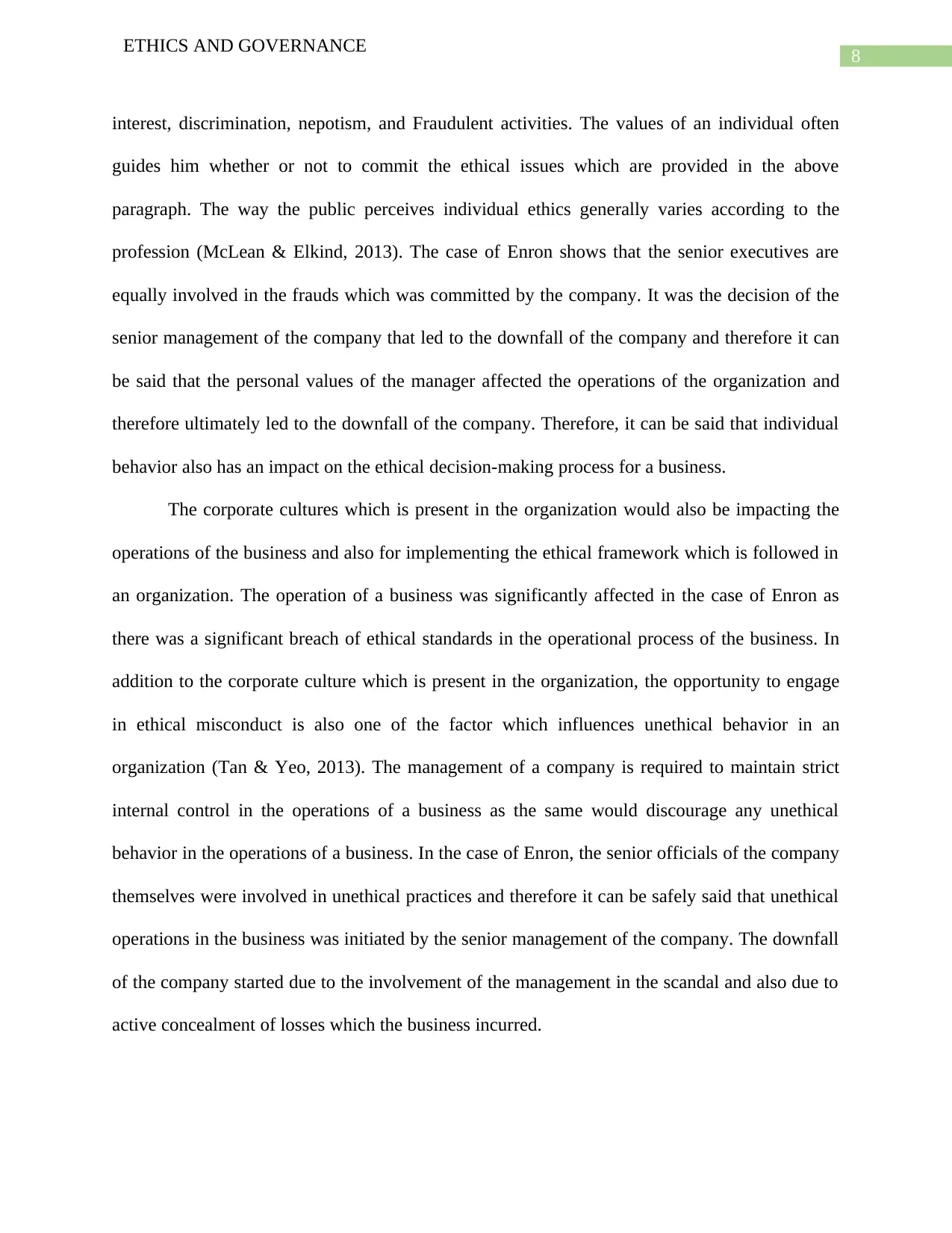
8
ETHICS AND GOVERNANCE
interest, discrimination, nepotism, and Fraudulent activities. The values of an individual often
guides him whether or not to commit the ethical issues which are provided in the above
paragraph. The way the public perceives individual ethics generally varies according to the
profession (McLean & Elkind, 2013). The case of Enron shows that the senior executives are
equally involved in the frauds which was committed by the company. It was the decision of the
senior management of the company that led to the downfall of the company and therefore it can
be said that the personal values of the manager affected the operations of the organization and
therefore ultimately led to the downfall of the company. Therefore, it can be said that individual
behavior also has an impact on the ethical decision-making process for a business.
The corporate cultures which is present in the organization would also be impacting the
operations of the business and also for implementing the ethical framework which is followed in
an organization. The operation of a business was significantly affected in the case of Enron as
there was a significant breach of ethical standards in the operational process of the business. In
addition to the corporate culture which is present in the organization, the opportunity to engage
in ethical misconduct is also one of the factor which influences unethical behavior in an
organization (Tan & Yeo, 2013). The management of a company is required to maintain strict
internal control in the operations of a business as the same would discourage any unethical
behavior in the operations of a business. In the case of Enron, the senior officials of the company
themselves were involved in unethical practices and therefore it can be safely said that unethical
operations in the business was initiated by the senior management of the company. The downfall
of the company started due to the involvement of the management in the scandal and also due to
active concealment of losses which the business incurred.
ETHICS AND GOVERNANCE
interest, discrimination, nepotism, and Fraudulent activities. The values of an individual often
guides him whether or not to commit the ethical issues which are provided in the above
paragraph. The way the public perceives individual ethics generally varies according to the
profession (McLean & Elkind, 2013). The case of Enron shows that the senior executives are
equally involved in the frauds which was committed by the company. It was the decision of the
senior management of the company that led to the downfall of the company and therefore it can
be said that the personal values of the manager affected the operations of the organization and
therefore ultimately led to the downfall of the company. Therefore, it can be said that individual
behavior also has an impact on the ethical decision-making process for a business.
The corporate cultures which is present in the organization would also be impacting the
operations of the business and also for implementing the ethical framework which is followed in
an organization. The operation of a business was significantly affected in the case of Enron as
there was a significant breach of ethical standards in the operational process of the business. In
addition to the corporate culture which is present in the organization, the opportunity to engage
in ethical misconduct is also one of the factor which influences unethical behavior in an
organization (Tan & Yeo, 2013). The management of a company is required to maintain strict
internal control in the operations of a business as the same would discourage any unethical
behavior in the operations of a business. In the case of Enron, the senior officials of the company
themselves were involved in unethical practices and therefore it can be safely said that unethical
operations in the business was initiated by the senior management of the company. The downfall
of the company started due to the involvement of the management in the scandal and also due to
active concealment of losses which the business incurred.
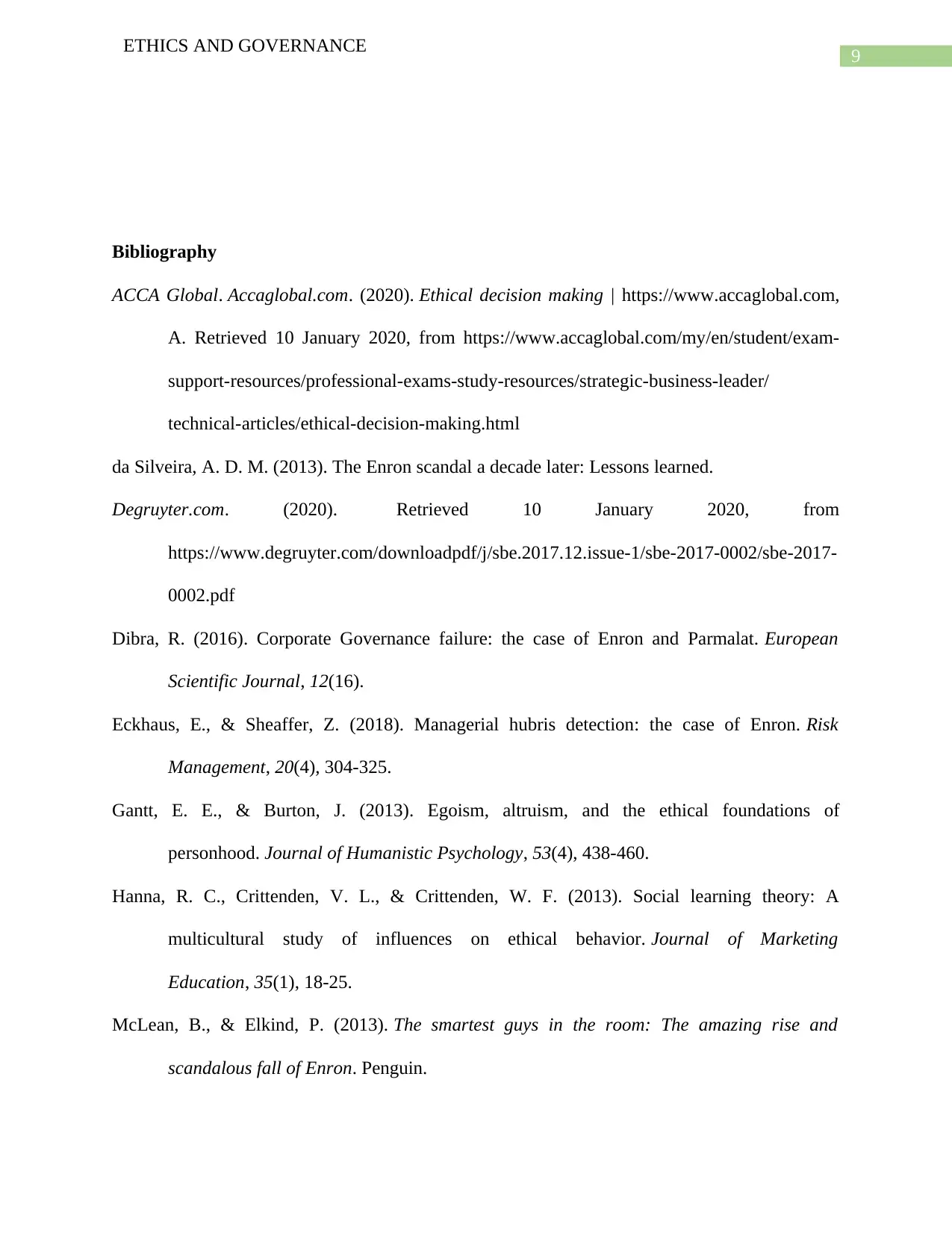
9
ETHICS AND GOVERNANCE
Bibliography
ACCA Global. Accaglobal.com. (2020). Ethical decision making | https://www.accaglobal.com,
A. Retrieved 10 January 2020, from https://www.accaglobal.com/my/en/student/exam-
support-resources/professional-exams-study-resources/strategic-business-leader/
technical-articles/ethical-decision-making.html
da Silveira, A. D. M. (2013). The Enron scandal a decade later: Lessons learned.
Degruyter.com. (2020). Retrieved 10 January 2020, from
https://www.degruyter.com/downloadpdf/j/sbe.2017.12.issue-1/sbe-2017-0002/sbe-2017-
0002.pdf
Dibra, R. (2016). Corporate Governance failure: the case of Enron and Parmalat. European
Scientific Journal, 12(16).
Eckhaus, E., & Sheaffer, Z. (2018). Managerial hubris detection: the case of Enron. Risk
Management, 20(4), 304-325.
Gantt, E. E., & Burton, J. (2013). Egoism, altruism, and the ethical foundations of
personhood. Journal of Humanistic Psychology, 53(4), 438-460.
Hanna, R. C., Crittenden, V. L., & Crittenden, W. F. (2013). Social learning theory: A
multicultural study of influences on ethical behavior. Journal of Marketing
Education, 35(1), 18-25.
McLean, B., & Elkind, P. (2013). The smartest guys in the room: The amazing rise and
scandalous fall of Enron. Penguin.
ETHICS AND GOVERNANCE
Bibliography
ACCA Global. Accaglobal.com. (2020). Ethical decision making | https://www.accaglobal.com,
A. Retrieved 10 January 2020, from https://www.accaglobal.com/my/en/student/exam-
support-resources/professional-exams-study-resources/strategic-business-leader/
technical-articles/ethical-decision-making.html
da Silveira, A. D. M. (2013). The Enron scandal a decade later: Lessons learned.
Degruyter.com. (2020). Retrieved 10 January 2020, from
https://www.degruyter.com/downloadpdf/j/sbe.2017.12.issue-1/sbe-2017-0002/sbe-2017-
0002.pdf
Dibra, R. (2016). Corporate Governance failure: the case of Enron and Parmalat. European
Scientific Journal, 12(16).
Eckhaus, E., & Sheaffer, Z. (2018). Managerial hubris detection: the case of Enron. Risk
Management, 20(4), 304-325.
Gantt, E. E., & Burton, J. (2013). Egoism, altruism, and the ethical foundations of
personhood. Journal of Humanistic Psychology, 53(4), 438-460.
Hanna, R. C., Crittenden, V. L., & Crittenden, W. F. (2013). Social learning theory: A
multicultural study of influences on ethical behavior. Journal of Marketing
Education, 35(1), 18-25.
McLean, B., & Elkind, P. (2013). The smartest guys in the room: The amazing rise and
scandalous fall of Enron. Penguin.
Secure Best Marks with AI Grader
Need help grading? Try our AI Grader for instant feedback on your assignments.
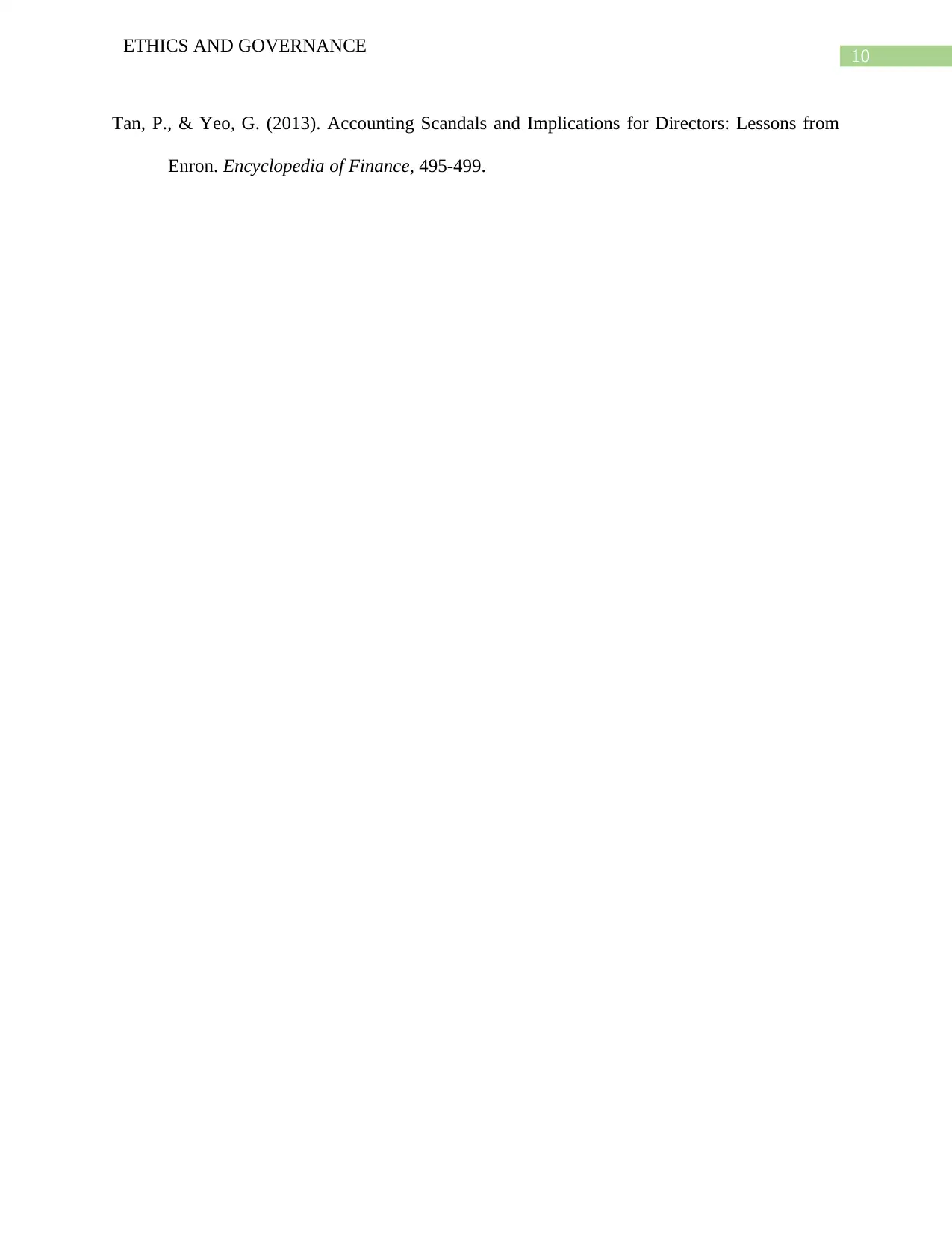
10
ETHICS AND GOVERNANCE
Tan, P., & Yeo, G. (2013). Accounting Scandals and Implications for Directors: Lessons from
Enron. Encyclopedia of Finance, 495-499.
ETHICS AND GOVERNANCE
Tan, P., & Yeo, G. (2013). Accounting Scandals and Implications for Directors: Lessons from
Enron. Encyclopedia of Finance, 495-499.
1 out of 11
Related Documents
Your All-in-One AI-Powered Toolkit for Academic Success.
+13062052269
info@desklib.com
Available 24*7 on WhatsApp / Email
![[object Object]](/_next/static/media/star-bottom.7253800d.svg)
Unlock your academic potential
© 2024 | Zucol Services PVT LTD | All rights reserved.





